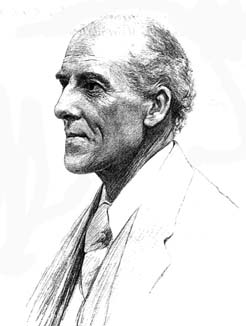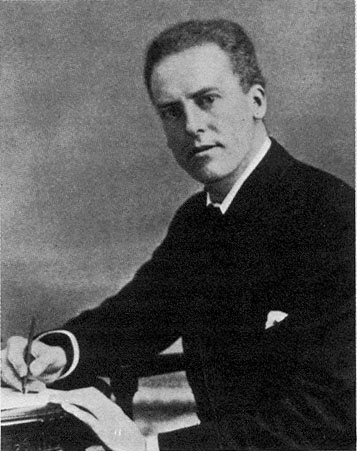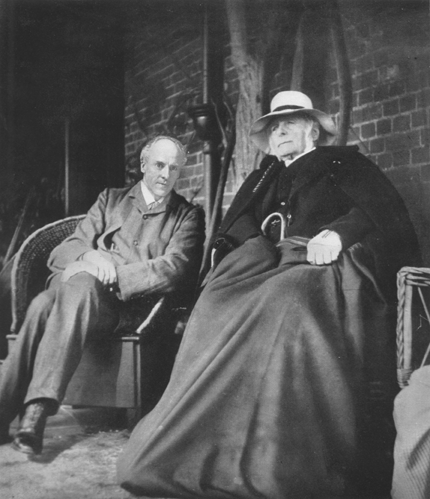<Back to Index>
- Mathematician Karl Pearson, 1857
- Photographer Edward Jean Steichen, 1879
- Prince of Transylvania Francis II Rákóczi, 1676
PAGE SPONSOR



Karl Pearson FRS (27 March 1857 – 27 April 1936) established the discipline of mathematical statistics.
In 1911
he founded the world's first university statistics department at University
College London. He was a proponent of eugenics,
and a protégé and biographer of Sir Francis
Galton. A sesquicentenary conference was held in
London on 23 March 2007, to celebrate the 150th anniversary of his
birth. Carl
Pearson, later known as Karl Pearson (1857 – 1936) was born to William
Pearson and Fanny Smith, who had three children, Aurthur, Carl (Karl)
and Amy. William Pearson also sired an illegitimate son, Frederick
Mockett. Pearson's mother, née Fanny Smith, came from a family
of master mariners who sailed their own ships from Hull;
his father read law at Edinburgh and was a successful
barrister and Queen's Counsel (QC). William Pearson's
father's family came from the North Riding of
Yorkshire. The family grave is at Crambe,
near York. Its motto, "ERIMUS" means "We shall be", and is also the
motto of the Middlesbrough coat-of-arms. "Carl
Pearson" inadvertently became "Karl Pearson" when he enrolled at the University of
Heidelberg in
1879, which changed the spelling. He used both variants of his name
until 1884 when he finally adopted Karl — supposedly also after Karl Marx, though some
argue otherwise. Eventually he became
universally known as "KP". He was
also an accomplished historian and Germanist.
He spent much of the 1880s in Berlin, Heidelberg, Vienna, Saig bei
Lenzkirch, and Brixlegg.
He wrote on Passion plays,
religion, Goethe, Werther,
as well as sex-related themes, and was a founder of the Men and Women's
Club. In
1890 he married Maria Sharpe who was related to the Kenrick, Reid,
Rogers and Sharpe families, late 18th century and 19th century
non-conformists largely associated with north London; they included: Samuel Rogers,
poet (1763 – 1855); Sutton Sharpe (1797 – 1843), barrister; Samuel Sharpe,
Egyptologist and philanthropist (1799 – 1881); John Kenrick,
a non-Conformist minister (1788 – 1877). Karl and Maria Pearson had two
daughters, Sigrid Loetitia Pearson and Helga Sharpe Pearson, and one
son, Egon Sharpe
Pearson. Egon Pearson became an eminent statistician himself,
establishing the Neyman-Pearson
lemma. He succeeded his father as head of the Applied Statistics
Department at University College. Karl
Pearson was educated privately at University
College School, after which he went to King's College,
Cambridge, in 1876
to study mathematics. He
then spent part of 1879 and 1880 studying medieval and 16th century German
literature at
the universities of Berlin and Heidelberg – in fact, he became
sufficiently knowledgeable in this field that he was offered a Germanics post at Kings College,
Cambridge. He
graduated from Cambridge University in 1879 as Third Wrangler in the Mathematical
Tripos. He then travelled to Germany to study physics at the University of
Heidelberg under G H Quincke and metaphysics under Kuno Fischer.
He next visited the University of
Berlin, where he attended the lectures of the famous physiologist Emil du
Bois-Reymond on Darwinism (Emil was a brother of Paul du
Bois-Reymond, the mathematician). Other subjects which he
studied in Berlin included Roman Law, taught by Bruns and Mommsen,
medieval and 16th century German Literature, and Socialism. He was
strongly influenced by the courses he attended at this time and he
became sufficiently expert on German literature that he was offered a
post in the German Department of Cambridge University. On returning to
England in 1880, Pearson first went to Cambridge: Back
in Cambridge, I worked in the engineering shops, but drew up the
schedule in Mittel- and Althochdeutsch for the Medieval Languages
Tripos. In his
first book, The New
Werther, Pearson gives a clear indication of why he studied so many
diverse subjects: I
rush from science to philosophy, and from philosophy to our old friends
the poets; and then, over-wearied by too much idealism, I fancy I
become practical in returning to science. Have you ever attempted to
conceive all there is in the world worth knowing — that not one subject
in the universe is unworthy of study? The giants of literature, the
mysteries of many-dimensional space, the attempts of Boltzmann and
Crookes to penetrate Nature's very laboratory, the Kantian theory of
the universe, and the latest discoveries in embryology, with their
wonderful tales of the development of life — what an immensity beyond
our grasp! … Mankind seems on the verge of a new and glorious
discovery. What Newton did to simplify the planetary motions must now
be done to unite in one whole the various isolated theories of
mathematical physics. Pearson
then returned to London to study law so that he might, like his father,
be called to the Bar. Quoting Pearson's own account: Coming to
London, I read in chambers in Lincoln's Inn, drew up bills of sale, and
was called to the Bar, but varied legal studies by lecturing on heat at
Barnes, on Martin Luther at Hampstead, and on Lasalle and Marx on
Sundays at revolutionary clubs around Soho. His next
career move was to Inner Temple,
where he read law until 1881 (although he
never practised). After this, he returned to mathematics,
deputizing for the mathematics professor at King's College
London in 1881
and for the professor at University
College London in
1883. In 1884, he was appointed to the Goldsmid Chair of Applied
Mathematics and Mechanics at University College London. Pearson became
the editor of Common
Sense and the Exact Sciences (1885)
when William Kingdon
Clifford passed
on. 1891 saw him also appointed to the professorship of Geometry at Gresham College;
here he met Walter Frank
Raphael Weldon, a zoologist who had some interesting problems
requiring quantitative solutions. The collaboration, in biometry and evolutionary theory, was a fruitful one
and lasted until Weldon died in 1906. Weldon introduced Pearson to Charles Darwin's
cousin Francis Galton,
who was interested in aspects of evolution such as heredity and eugenics.
Pearson became Galton's protégé — his "statistical heir"
as some have put it — at times to the verge of hero worship. After
Galton's death in 1911, Pearson embarked on producing his definitive
biography — a three-volume tome of narrative, letters, genealogies,
commentaries, and photographs — published in 1914, 1924, and 1930, with
much of Pearson's own financing paying for their print runs. The
biography, done "to satisfy myself and without regard to traditional
standards, to the needs of publishers or to the tastes of the reading
public", triumphed Galton's life, work, and personal heredity. He
predicted that Galton, rather than Charles Darwin,
would be remembered as the most prodigious grandson of Erasmus Darwin.
When Galton died, he left the residue of his estate to the University of
London for a
Chair in Eugenics. Pearson was the first holder of this chair — the Galton Chair of Eugenics,
later the Galton
Chair of Genetics —
in accordance with Galton's wishes. He formed the Department of Applied
Statistics (with financial support from the Drapers' Company),
into which he incorporated the Biometric and Galton laboratories. He
remained with the department until his retirement in 1933, and
continued to work until his death in 1936. When the
23 year-old Albert Einstein started a study group, the Olympia Academy,
with his two younger friends, Maurice
Solovine and Conrad
Habicht, he suggested that the first book to be read was
Pearson's The Grammar of
Science.
This book covered several themes that were later to become part of the
theories of Einstein and other scientists. Pearson asserted that the
laws of nature are relative to the perceptive ability of the observer.
Irreversibility of natural processes, he claimed, is a purely relative
conception. An observer who travels at the exact velocity of light
would see an eternal now, or an absence of motion. He speculated that
an observer who traveled faster than light would see time reversal,
similar to a cinema film being run backwards. Pearson also discussed antimatter,
the fourth dimension,
and wrinkles in time. Pearson's relativity was based on idealism,
in the sense of ideas or pictures in a mind.
"There are many signs," he wrote, "that a sound idealism is surely
replacing, as a basis for natural philosophy, the crude materialism of the older physicists."
(Preface to 2nd Ed., The Grammar of
Science)
Further, he stated, "...science is in reality a classification and
analysis of the contents of the mind...." "In truth, the field of
science is much more consciousness than an external world." An
aggressive eugenicist who applied his social Darwinism to entire
nations, Pearson openly advocated "war" against "inferior races," and
saw this as a logical implication of his scientific work on human
measurement: "My view – and I think it may be called the scientific
view of a nation," he wrote," – is that of an organized whole, kept up
to a high pitch of internal efficiency by insuring that its numbers are
substantially recruited from the better stocks, and kept up to a high
pitch of external efficiency by contest, chiefly by way of war with
inferior races." He reasoned that, if August Weismann's
theory
of germ plasm is correct, then the nation is wasting money when
it tries to improve people who come from poor stock. Weismann claimed
that acquired characteristics could not be inherited. Therefore,
training benefits only the trained generation. Their children will not
exhibit the learned improvements and, in turn, will need to be
improved. "No degenerate and feeble stock will ever be converted into
healthy and sound stock by the accumulated effects of education, good
laws, and sanitary surroundings. Such means may render the individual
members of a stock passable if not strong members of society, but the
same process will have to be gone through again and again with their
offspring, and this in ever-widening circles, if the stock, owing to
the conditions in which society has placed it, is able to increase its
numbers." (Introduction,The Grammar of
Science). "History
shows me one way, and one way only, in which a high state of
civilization has been produced, namely, the struggle of race with race,
and the survival of the physically and mentally fitter race. If you
want to know whether the lower races of man can evolve a higher type, I
fear the only course is to leave them to fight it out among themselves,
and even then the struggle for existence between individual and
individual, between tribe and tribe, may not be supported by that
physical selection due to a particular climate on which probably so
much of the Aryan's success depended . . ." (Karl Pearson, National
Life from the Standpoint of Science [London, 1905]) Pearson
was known in his lifetime as a prominent "freethinker" and socialist.
He gave lectures on such issues as "the woman's question" (this was the
era of the suffragist movement in the UK) and upon Karl Marx.
His commitment to socialism and its ideals led him to
refuse the offer of being created an OBE (Officer of the
Order of the British Empire) in 1920, and also to refuse a Knighthood in 1935. Pearson
achieved widespread recognition across a range of disciplines and his
membership of, and awards from, various professional bodies reflects
this: 1896: elected FRS:
Fellow of the Royal
Society; 1898:
awarded the Darwin Medal (not to be confused with the Darwin Awards);
1911: awarded the honorary degree of LLD from the University of
St Andrews; 1911: awarded a DSc from University of London;
1920: offered (and refused) the OBE; 1932:
awarded the Rudolf Virchow medal by the Berliner Anthropologische
Gesellschaft; 1935: offered (and refused) a knighthood.
He
was also elected an Honorary Fellow of King's College Cambridge, the
Royal Society of Edinburgh, University College London and the Royal
Society of Medicine, and a Member of the Actuaries' Club. Pearson's
work was all-embracing in the wide application and development of
mathematical statistics, and encompassed the fields of biology, epidemiology,
anthropometry, medicine and social history.
In 1901, with Weldon and Galton, he founded the journal Biometrika whose object was the
development of statistical theory. He edited this journal until his
death. He also founded the journal Annals of Eugenics (now Annals of Human
Genetics) in 1925. He published the Drapers' Company Research Memoirs largely to provide a record
of the output of the Department of Applied Statistics not published
elsewhere. Pearson's
thinking underpins many of the 'classical' statistical methods which
are in common use today. Examples of his contributions are: